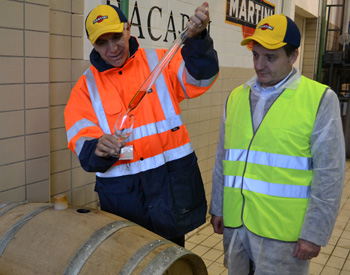We spend three days with Martini’s Beautiful Drinks programme in the heart of Italy, learning all about Vermouth.

Different drinks brands mean different things to different people. For me, the red and blue Martini logo will always look best on the door of a Lancia HF Intergrale.
During the 1980s, the Martini Lancia racing team won just about every rally there was, and stepping onto the terrace of Martini’s Pessione headquarters and museum, I spied the familiar boxy shape of an HF through a window across the courtyard.
Martini ambassador, Giuseppe Gallo, confirmed: “yep, that’s the actual car that won all the races”, and I felt like I had met a childhood hero.
The Martini Beautiful Drinks programme breaks down into two broad subjects – wine and botanicals. Tackling the first, Martini’s rather lovely headquarters has its own wine museum, with artifacts dating back to mankind’s very first attempts at wine production.

The museum spans 2000 years of history, is the biggest in Europe and even has ancient Egyptian artifacts on loan from the Museum of Turin.
Slowly walking around, looking at amphora, incredibly old wine presses and Roman drinking vessels, it is clear a great deal of time, effort and money have gone into building the collection, and this visit alone made the trip worth attending.
Blend it yerself
However, this was just the first part of the programme, laying the foundations for a session spent in the Martini Aroma Room with artisan Beppe Musso.

Beppe spoke to us about the Vino Fiore that is the main constituent part of Martini, and how it is blended with various botanicals to create vermouth. We were then split into groups and invited to blend our own, with varying results. BarLifeUK’s tasted like time-expired cough syrup, but some of the bartender’s concoctions won Beppe’s approval.
We also spent some time with Martini’s master herbalist, Ivano Tonutti. BarLifeUK have met Ivano before, and were left then with the impression that what this man doesn’t know about herbs and botanicals, isn’t worth knowing.
Ivano accompanied the group to nearby Pancallieri, a mecca for botanicals production. So much so, that it is home to the Aromatic Plants Museum, which documents the region’s herb-growing history.
For me, the best thing about the Aromatic Plant Museum is a room with black and white photos of ‘back in the day’ farm workers, and some videos of the old timers talking about their work. While the graft was hard, they clearly loved what they did, and the fruit (sic) of their labour was deeply embedded in their entire culture – food, medicine and drinks all relied heavily on the region’s aromatic herbs.
Minty finger
We then visited a farm and saw huge carts, groaning under the weight of tons of Artemesia waiting for processing. The farm also distilled its own harvest, passing on the resulting liquid to Martini for use in its products.

One by one will were allowed to daintily touch a fingertip to the still and collect a tiny drop of pure peppermint distillate. The still reduces 1 ton of peppermint into 4 kilos of liquid, and I can tell you now, I’ve never tasted anything like it.
Gingerly touching it to my tongue, my mouth instantly turned itself inside out. The rush of flavour and fumes was almost overwhelming, and I was quite glad when it subsided. Five minutes later, the group had the clearest sinuses ever, and my fingers still smelled of mint the next day.
Our group experienced the full VIP treatment, and were allowed to visit the Martini distillation room, which is normally off limits to visitors.
Outside the room are huge cylindrical tanks called Tamburo. These are filled with botanicals and pure alcohol and rotate at an incredibly slow rate – just 2 revolutions per day – for 2 to 4 weeks, creating a pure elixir for use in Martini’s various expressions.
Ivano’s mystery box

Inside the distillation room, Ivano produced a large sealed cardboard box that contained the botanicals required for a single run. But such is the secrecy surrounding Martini’s recipes, he would not reveal which expression it was for.
However, it was fascinating to see the raw materials up close, and the smell coming from the box was something to behold too.
Just before we left the room, Ivano pointed to some large barrels resting by the wall, and asked if we would like to taste one of their experiments. The answer was, of course, yes and so we had a generous taste of Martinez that had been aging in the barrel for 2 years, and to quote the Bible, It Was Good.
Martini is a huge brand that sells enormous amounts of product throughout the World, and once again my expectations of a soulless, mechanised process were proved wrong.

The local farmers who grow the aromatic herbs are clearly passionate about what they do, and are full of the kind of regional, ‘my family has been doing this for 200 years’ knowledge that is just not replicable by outsiders.
If the liquid is to taste the way it tastes now, the local growers in Italy, and their counterparts elsewhere on the globe, have to keep doing things their way, and long may they do so.
On a more stomach-related note, the Beautiful Drinks trip took us to some great restaurants and I ate some of the best food I’ve had in ages. The hospitality displayed by everyone at Martini and the various hotels we stayed at was impeccable, and if you get the chance to go next year, jump on it.
And Mr Giuseppe Gallo, I haven’t forgotten what you said on the terrace – Next year when the building work is finished, I’m going to come back and drive that Lancia.

